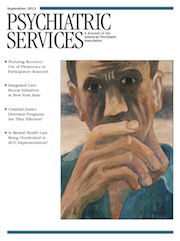Inequalities in the Use of Services Provided by Psychiatrists in Spain: A Multilevel Study
Abstract
Objective
The objective was to identify individual or contextual inequalities in visits to psychiatrists in Spain, a country with a regionalized health care system and variable integration of mental health and primary care.
Methods
This cross-sectional study used data for the noninstitutionalized population from the 2006 Spanish Health Interview Survey (N=29,478). A score of ≥3 on the General Health Questionnaire represented a need for mental health care. The probability of having visited a psychiatrist in the previous four weeks was analyzed in relation to individual-level variables (age, social class, health insurance, and country of origin) and contextual socioeconomic variables (Gross Domestic Product; a measure of income equality; and characteristics of regional mental health systems, such as human resources, services, and organization). Multilevel logistic regression models were used.
Results
A total of 161 individuals (.55% of the sample) reported a visit to a psychiatrist during the previous four weeks. Individuals age 65 and older and immigrants from low-income countries were less likely to report a visit. Visits to psychiatrists were more common in regions with higher rates of psychiatrists per hospital (odds ratio [OR]=1.47, 95% confidence interval [CI]=1.18–1.83), more human resources for mental health (OR=1.03, CI=1.01–1.06), and better integration of primary care and specialized mental health care (OR=1.90, CI=1.32–2.76).
Conclusions
Individual and contextual inequalities in use of psychiatrists’ services exist in Spain. Better coordination between primary and mental health care and greater availability of mental health resources were associated with greater use. Policies seeking better integration of care should be promoted.



